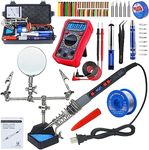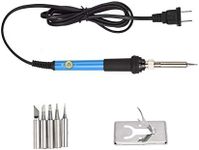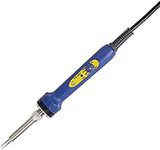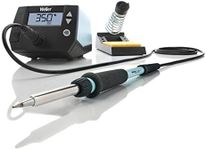Buying Guide for the Best Glass Soldering Iron
Choosing the right glass soldering iron is important for anyone working with stained glass, glass fusing, or other glass art projects. The right tool will help you achieve clean, strong joints and make your work more enjoyable and efficient. When picking a glass soldering iron, it's important to understand the key features that affect performance, comfort, and suitability for your specific projects. By learning about these specifications, you can match your needs to the right tool and avoid frustration or poor results.WattageWattage refers to the power output of the soldering iron, which affects how quickly and efficiently it heats up and maintains temperature. For glass work, higher wattage irons (typically 80 watts and above) are better for melting solder smoothly and consistently, especially when working on larger pieces or using lead came. Lower wattage irons (below 60 watts) may struggle to maintain heat, leading to poor solder joints. If you mostly work on small, delicate projects, a mid-range wattage may be sufficient, but for larger or more frequent work, a higher wattage iron is usually the best choice.
Temperature ControlTemperature control allows you to adjust the heat of your soldering iron, which is important for working with different types of solder and glass. Some irons have fixed temperatures, while others offer adjustable controls. Adjustable temperature is useful if you work with a variety of materials or want more precision, while fixed temperature irons are simpler and may be suitable for beginners or those who always use the same type of solder. Consider your project variety and whether you need flexibility or simplicity.
Tip Type and SizeThe tip of the soldering iron comes in different shapes and sizes, such as chisel, pointed, or flat. The tip type affects how the heat is applied and how easy it is to control the solder flow. Larger, chisel tips are good for broad seams and heavy-duty work, while finer, pointed tips are better for detailed or delicate soldering. Choose a tip that matches the scale and detail of your typical projects; some irons allow you to swap tips for versatility.
Heating Element TypeThe heating element is the part of the iron that generates heat. Common types include ceramic and metal-core elements. Ceramic elements heat up quickly and maintain a stable temperature, making them ideal for consistent work. Metal-core elements may take longer to heat and can be less stable. If you value quick start-up and steady performance, look for a ceramic heating element.
Handle Comfort and InsulationThe handle of the soldering iron should be comfortable to hold and well-insulated to protect your hand from heat. Ergonomic handles reduce fatigue during long sessions, and good insulation prevents burns. If you plan to work for extended periods, prioritize a handle that feels good in your hand and stays cool.
Cord Length and FlexibilityCord length and flexibility affect how easily you can move the iron around your workspace. A longer, flexible cord gives you more freedom of movement, which is especially helpful for larger projects or awkward angles. If your workspace is limited or you work on small pieces, cord length may be less important, but flexibility is always helpful for comfort and safety.










